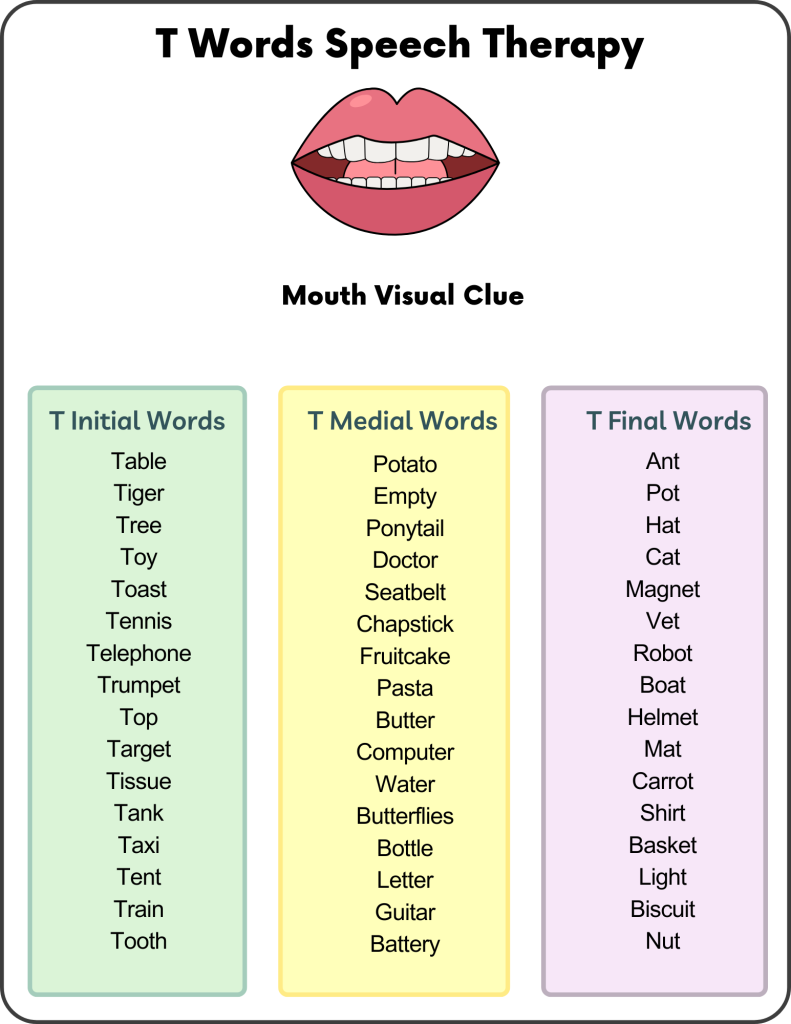S Words in Speech Therapy
November 18, 2025V Words in Speech Therapy
November 19, 2025Introduction to T Words in Speech Therapy
Hello, parents! If your child is having difficult to say T sound, this guide is here to help. The T sound—a voiceless alveolar stop made by pressing the tongue tip against the upper ridge behind the teeth and releasing it without voice—is typically mastered by age 4, but some kids may substitute it with “D” (e.g., “dop” for “top”) or struggle with its crispness. This article provides lists of T initial, medial, and final words, plus practical tips to make practice fun and effective at home, equipping you to boost your child’s speech clarity.

T Words Speech Therapy Printable PDF Worksheet
Understanding T Word Positions
- Initial T Words: These begin with T, like “top” or “toy,” where the sound starts with a sharp, voiceless pop.
- Medial T Words: These have T in the middle, such as “butter” or “water,” blending T with other sounds.
- Final T Words: These end with T, like “cat” or “hat,” requiring a clean, voiceless finish.
Lists of T Words for Practice
Below are curated lists of T words for each position, suitable for home use and integrated into daily activities.
T Initial Words
- Table
- Tiger
- Tree
- Toy
- Toast
- Tennis
- Telephone
- Trumpet
- Tumble
- Target
- Tissue
- Tank
- Taxi
- Tent
- Train
- Tooth
T Medial Words
- Potato
- Empty
- Ponytail
- Doctor
- Seatbelt
- Chapstick
- Fruitcake
- Pasta
- Butter
- Computer
- Water
- Butterflies
- Bottle
- Letter
- Guitar
- Battery
T Final Words
- Ant
- Pot
- Hat
- Cat
- Magnet
- Vet
- Robot
- Boat
- Helmet
- Mat
- Carrot
- Shirt
- Basket
- Light
- Biscuit
- Nut
Tips for Parents to Support Practice
Here’s how to help your child with T words at home:
- Pop the T: Say “top” with a quick puff (like a tiny cough) to emphasize the voiceless stop—try it with a feather to show air!
- Use in Chat: Slip words into talk, like “Tap the toy,” during playtime.
- Repeat with Bounce: Say “tick, tick, tick” like a clock to reinforce the sound.
- Model the Crispness: Sharpen the “t” (e.g., “T-t-tree”), showing no voice, and cheer their tries.
- Add Actions: Pair “tug” with a pull or “tea” with a sip—find more ideas at
If your child continues to struggle with the T sound after practice, consider seeking help from a speech therapist for personalized guidance.. The T sound is a doorway to clear speech, and you’re ready to help your child master it! With these T initial, medial, and final word lists and easy home tips, practice can be a delight. Keep it steady and playful, and don’t hesitate to seek a professional speech therapist if needed.

